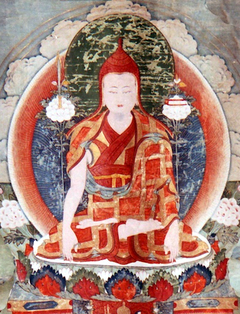The Definitive Essence of Awakening
The Definitive Essence of Awakening
by Longchen Rabjam
Paying homage to the supreme guru,
The great source of all profound meaning,
I shall write the definitive essence of awakening,
The most secret and unsurpassable instruction.
As an aid to the direct practice of the essential meaning, there follows a meditation on the profundity of great, naturally manifest wisdom.
Sit cross-legged on a comfortable seat, with your hands covering your knees, your lower belly drawn in, and head tilted slightly back. Allow your breath to flow naturally. Draw the lower breath upward and gently press down the upper breath. Visualize the three channels running through the heart of the four chakras, and within the central channel a red a-stroke at the level of the navel, from which a small flame emerges.[1] The fire extends upwards and touches the white haṃ (ཧཾ) at the crown chakra of great bliss. This causes a drops of bodhicitta nectar to descend and fill the chakra of enjoyment at the throat. As it descends further, it penetrates the blue é (ཨེ) in the middle of the dharma-chakra at the heart. Focus for a moment on the pulsating and pervasive bliss that this inspires. Then as the nectar reaches the radial channels of emanation at the navel, it touches the a-stroke and rekindles the fire. The combined white and red bodhicitta essences pervade your entire body, right to the pores of the skin, bringing all-encompassing bliss. Meditating on this for a long time causes coarse and subtle thoughts to fade within the experience of great bliss. Focus undistractedly on this mind of bliss. Such meditation causes the great union of śamatha and vipaśyanā, the primordial wisdom of non-conceptuality, bliss and clarity, to arise.
The meditation on inconceivable luminosity is as follows. From the haṃ at the crown a white thumb-sized sphere containing all the white essences descends. At the same time, a thumb-sized sphere containing all the red essences ascends from the a at the navel. They become fused at the é at the heart. Focus the mind on this thumb-sized, five-coloured bindu of light in which white and red essences are fused together, and meditate for a while on the experience of luminosity. This will induce the visions that are the hallmarks of luminosity—smoke, mirage, and the rest.[2] Then the orb of light diminishes in size until it finally disappears. Meditate evenly on the experience of immateriality. This will bring about the dawning of space-like wisdom, in which there are none of the fluctuations of the ordinary mind. As you abide by this experience for longer and longer, abundant signs of progress and countless temporary and ultimate qualities will unfold:
- The external, internal and intermediate will merge as one, and you will have a sense of being bodiless.
- You will lose any conceptual fixation.
- You will be unable to part from meditative equipoise.
- Everything will be experienced as bliss.
- You will no longer crave verbal expression.
- Grasping, however coarse or subtle, will dissolve.
- You will not waver from clear light, day and night.
- You will develop a radiant glow.
- Ḍākinīs will naturally gather around you.
- People will heed your commands.
- You will live long and enjoy abundant resources.
- You will experience the wisdom of luminosity at death.
- After your death, you will leave a body of light and sacred relics (ringsel).
- In the bardo, you will attain full awakening in the primordial state.
This quintessence of the most profound instruction
Is crucial as an aid to the direct form of meditation.
The fortunate should thus practice it with diligence.
Through its virtue, may all reach supreme awakening.
This concludes The Definitive Essence of Awakening composed by Longchen Rabjam, a yogin of the supreme vehicle, at the site of glorious inconceivability. May it be virtuous! Virtuous! Virtuous!
| Translated by Adam Pearcey with the generous support of the Tsadra Foundation, 2024.
Bibliography
Tibetan Edition
klong chen rab 'byams pa dri med 'od zer. "nges don byang chub snying po" In snying thig ya bzhi. 13 vols. Delhi: Sherab Gyaltsen Lama, 1975. Vol. 2: 306–309
Version: 1.0-20241217
